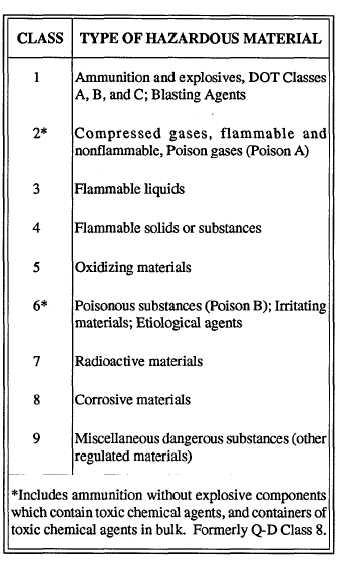Additionally, the following miscellaneous types of
magazines may be found at certain establishments.
KEYPORT. The keyport magazine is earth-
covered and arch-shaped with a prefabricated concrete
construction. It has interior floor dimensions of 6 feet
by 8 feet 8 inches.
The height of the arch is
approximately 6 feet.
BOX. A box magazine is of concrete construction,
rectangular shape, and normally measures 12 feet by 17
feet.
CORBETTA. A corbetta magazine is of concrete
construction and is shaped like a beehive or dome.
GALLERY. A gallery magazine is a tunnel or
cave, and the dimensions will vary.
MISCELLANEOUS OR NONSTANDARD.
The physical dimensions of the miscellaneous or
nonstandard magazine depend on the type of stowed
material and the location of the magazine.
OPEN STORAGE (REVETTED). The type and
amount of explosives stowed in open stowage (revetted)
depend on the size and location of the storage area.
Quantity-Distance (Q-D) Requirements
Quantity-distance (Q-D) requirements apply to the
concentration of ammunition, explosives, and other
hazardous materials at Naval Shore Establishments for
development; manufacturing; test and maintenance;
storage, loading and off-loading of vehicles, railcars and
aircraft; disposal; and all related handling incidents.
Quantity-distance (Q-D) requirements are based on
records of actual fires and explosions involving
ammunition and explosives. Q-D requirements
safeguard personnel against possible serious injury or
equipment destruction from possible fires or explosions.
These requirements also protect the inhabitants of
nearby communities, private and public property, and
the Naval Shore Establishment personnel. These
requirements keep the loss of valuable ammunition
stores (including inert ordnance items) to a minimum if
there were a fire or explosion.
The Department of Defense (DOD) Q-D hazard
classification system is based on a system recommended
for international use by the United Nations Organization
(UNO). The UNO system has nine classes of hazardous
material; but, DOD only uses three of the nine
classes—Class 1, explosives; Class 2, Division 3,
poison A, and Class 6, poisonous (toxic) and infectious
substances. Table 12-4 identifies each of the nine
classes.
Table 12-4.—United Nations Organization Hazard Classes
In reviewing table 12-4, you can see that some items
are placed in classes other than Class 1. Since DOD uses
only Class 1 items for explosives, Class 1 assignments
have been made. For example, fuel-air-explosive (FAE)
weapons without properly installed explosive
componments belong in UNO Class 3, while WP M23
igniters belong in UNO Class 4. However, to maintain
identity, DOD places these items in Class 1 for storage
only until DOD implements other classes. As an AO,
you are involved with the storage of Class 1 material;
therefore, the information contained in this section only
deals with Class 1 classifications.
DOD Hazard Class 1 is subdivided into divisions 1
through 5, based on the character and predominance of
the associated hazards and the potential for causing
personnel casualties or property damage. These sub-
division are not based upon compatibility groups or
12-5

